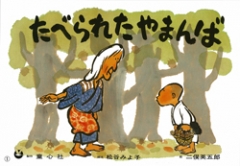
-
How the Witch was Eaten Up
Taberareta yamanba
Miyoko Matsutani , Eigoro Futamata / 16 sheets
This kamishibai retells the popular Japanese folktale Sanmai no fuda, or The Three Magic Charms. Miyoko Matsutani’s excellent text develops themes that run through the heart of many folktales: living life with spirit, the wisdom and strength to be found in common people. Eigoro Futamata’s illustrations deftly convey the atmosphere of the folktale and make expressive use of the kamishibai format. This work has come to represent folktale kamishibai both in Japan and abroad.
- ISBN978-4-494-07411-2
- ¥2,090E
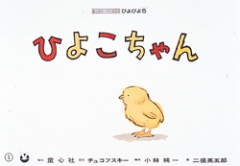
-
Baby Chick
Hiyoko-chan
Kornei Chukovskii, Jun’ichi Kobayashi, Eigoro Futamata / 12 sheets
A work by Russian author Kornei Chukovskii is rendered in verse-like text by poet Jun’ichi Kobayashi. In order to produce kyokan through communication, which is uniquely possible in kamishibai, the text repeats language such as hora (look here!), konna fu ni (like this), ne (you see?), to striking effect. Eigoro Futamata’s simple and lovely illustrations combine with the beautiful text in this long-selling kamishibai.
- ISBN978-4-494-07443-3
- ¥1,760E
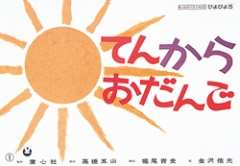
-
Dumplings from Heaven
Ten kara odango
Gozan Takahashi, Yukou Kanazawa / 12 sheets
This kamishibai is based on a 1948 work by Gozan Takahashi, known as a founder of kindergarten kamishibai. Yuko Kanazawa has faithfully brought the story to life again. Two story options are printed on the back of the sheets; the “spring version” is Gozan’s original. This story wraps listeners in a mysterious happiness, as though the life of the long-lived old woman has been handed to them. The “autumn version” of the work is Seishi Horio’s later adaptation and has a realistic, instructive aspect.
- ISBN978-4-494-07446-4
- ¥1,760E
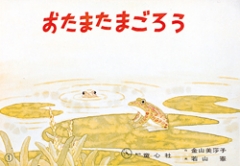
-
Tamagoro the Tadpole
Otama Tamagoro
Misako Kanayama, Ken Wakayama / 12 sheets
This visually beautiful kamishibai imparts the wish to grow by bringing viewers into sympathy with the tadpole Tamagoro. Ken Wakayama’s illustrations of nature touch the heart, opening a comfortable space of kyokan to the audience. In the midst of the quiet emotions that result, this kamishibai encourages children to look forward to their own growth.
- ISBN978-4-494-07457-0
- ¥1,760E
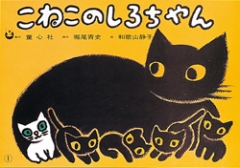
-
Shiro-chan, the Little White Kitten
Koneko no Shiro-chan
Seishi Horio, Shizuko Wakayama / 12 sheets
His mother and his siblings are all black, but little kitten Shiro-chan is white. His feelings as he longs to turn black touch the heart of the audience, thanks to Seishi Horio’s text plus Shizuko Wakayama’s illustrations, which possess a unique charm. The kamishibai gives children a feeling of delight and happiness in being themselves, just the way they are.
- ISBN978-4-494-07458-7
- ¥1,760E
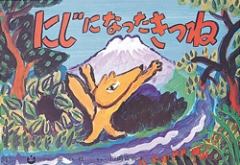
-
The Fox Who Became a Rainbow
Niji ni natta kitsune
Yuriko Kawada , Katsuji Fujita / 12 sheets
From time to time, folktales use animals to express and explore the meaning of human life. In this tale, the example of the fox Gorozaemon turning himself into a rainbow for the sake of an old man, expresses the wonderful, universal love that helps people summon their strength to help the weak. The charming final scene serves as inspiration to help others and live together in harmony.
- ISBN978-4-494-07476-1
- ¥1,760E
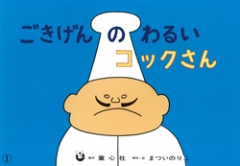
-
Mr. Cook in a Sulky Mood
Gokigen no warui kokku-san
Noriko Matsui / 12 sheets
This work makes deliberate use of the motion of sliding out sheets. As the audience calls “Look over here!” to Mr. Cook, who has turned his back in irritation at things around him, he turns and begins to cook something of his own, which delights everybody. The joy of eating candy all together becomes fused with the joy of living life just as we are, producing a deep sense of kyokan.
- ISBN978-4-494-07497-6
- ¥1,760E
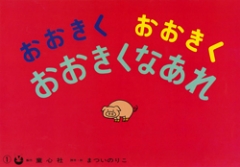
-
Grow Grow Grow Bigger!
Okiku okiku okiku na-are
Noriko Matsui / 8 sheets
This bestselling kamishibai won the 1983 Gozan Prize. Picture book and kamishibai author Noriko Matsui experimented with unique aspects of the format to open up the new world of audience-participation kamishibai. As viewers of this particular work take part by saying, “Grow grow grow bigger!” they voice the universal human wish for growth. A representative work that overflows with charm.
- ISBN978-4-494-07498-3
- ¥1,540E
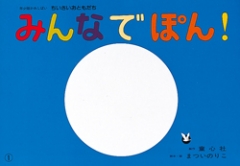
-
Everybody Clap!
Minna de pon
Noriko Matsui / 8 sheets
As everyone claps together (pon!), a dwarf bursts out of a large white circle. A robot jumps from a square, and a ghost pops out of a triangle. Everyone gets along and has a good time?what fun! Clapping itself is enjoyable, and the friends it summons add to the merriment. The dwarf, robot, and ghost serve as powerful symbols in this action-oriented audience-participation kamishibai.
- ISBN978-4-494-07499-0
- ¥1,540E
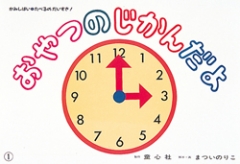
-
It’s Snack Time!
Oyatsu no jikan da yo
Noriko Matsui / 12 sheets
At snack time, will everyone have sweets and juice with lots of sugar? Or fruit and vegetable cakes and milk? There’s a sneaky devil out there who wants us to eat food that harms our bones, teeth, and body. This kamishibai takes the audience back in time, making effective use of the sliding out motion. The importance of considering health is imparted not with force, but very naturally in this enjoyable work.
- ISBN978-4-494-07500-3
- ¥1,760E
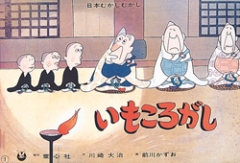
-
Tumbling Taros
Imo korogashi
Daiji Kawasaki, Kazuo Maekawa / 12 sheets
Japan’s many “priest and monk” folktales are said to have originated from a sense of resistance to authority. Daiji Kawasaki, who brilliantly evokes the spirit of common people in this story, showed a rebel spirit himself as the effective leader of postwar democratic cultural movements in Japan. He authored more than 140 kamishibai. Kazuo Maekawa’s comical illustrations add to the merriment.
- ISBN978-4-494-07504-1
- ¥1,760E
![The Amazing [“Ah”] Witch](/book_imgs_s/E9784494075256.jpg)
-
The Amazing [“Ah”] Witch
A no ji no mahotsukai
Yoshie Idemura, Akiko Nakane / 12 sheets
One category in which kamishibai titles are few is that of “learning.” Imparting joy in characters and words, themselves full of human wisdom and rich images, is something kyokan can do for children . . . With that in mind, respected educator and kamishibai performer Yoshie Idemura created this work. It promises to help children enjoy the expressive potential that dwells in words.
- ISBN978-4-494-07525-6
- ¥1,760E
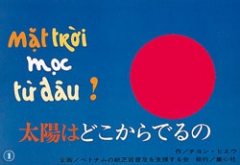
-
From Where Does the Sun Appear?
Taiyo wa doko kara deru no
Truong Van Hieu / 12 sheets
This is a kamishibai from Vietnam in which animals search for where the sun comes from. Author Truong Van Hie fought in the Vietnam War, seeking independence and freedom for his country. His life is condensed in this kamishibai, which depicts the search for truth with bold illustrations. This was the first kamishibai by a non-Japanese author to earn Honorable Mention in the Gozan Prize competition.
- ISBN978-4-494-07558-4
- ¥1,760E
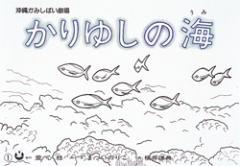
-
The Ocean of Kariyushi
Kariyushi no umi
Noriko Matsui, Kensuke Yokoi / 8 sheets
As everyone utters the Okinawan blessing yugafu tabori (may happiness come to us), color and life are breathed into black and white illustrations, and the ocean becomes beautiful again. The surprise and excitement of this moment are expressed with stunning photography. The sliding in and out of sheets in response to heartfelt wishes make this kyokan the unique product of kamishibai.
- ISBN978-4-494-07570-6
- ¥1,540E
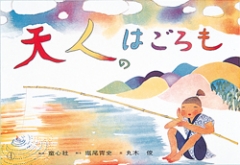
-
The Celestial Robe
Tennin no hagoromo
Horio Seishi , Toshi Maruki / 16 sheets
Hagoromo is a legend widely told throughout Japan, in which a heavenly lady comes to earth to retrieve her celestial robe. Writer Seishi Horio’s humanity makes this setting of the story particularly heartwarming. The impressively beautiful illustrations are the work of Toshi Maruki, known for the Hiroshima Murals. Her art for this kamishibai, first printed in 1961, capitalizes on special features of the format. A masterful retelling that could only have come to life as kamishibai.
- ISBN978-4-494-07593-5
- ¥2,090E
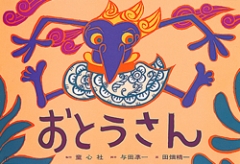
-
Father
Oto-san
Sumatran Folktale, Jun’ichi Yoda, Seiichi Tabata / 12 sheets
Seiichi Tabata’s superb illustrations for this work clearly show unique characteristics of visual expression possible in kamishibai. In addition, they convey the love shared between parent and child and impart a sense of sympathy for the lonely (in this case, the monster Mangalan Green Beku). Poet and children’s book author Jun’ichi Yoda wrote the text for a number of kamishibai and twice received the Gozan Prize (the highest annual distinction awarded for published kamishibai).
- ISBN978-4-494-07595-9
- ¥1,760E
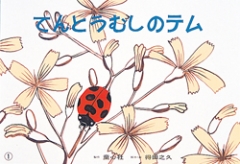
-
Temu the Ladybug
Tentomushi no Temu
Yukihisa Tokuda / 12 sheets
Yukihisa Tokuda is a researcher as well as an illustrator, and his fondness for insects spills into the art and text of this kamishibai. This work not only fosters enjoyment in learning about insects, but also invites children to share, via kyokan, the joy of being alive as they follow Temu on his journey. The vivid illustrations of insects and visual progression that capitalizes on the sliding out of sheets evokes a world that could only come to life through kamishibai.
- ISBN978-4-494-07596-6
- ¥1,760E
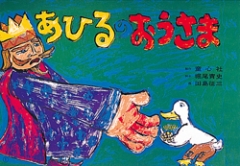
-
Duck the King
Ahiru no o-sama
French Folktale, Seishi Horio, Seizo Tashima / 12 sheets
This portrayal of a duck facing off with a tyrannical king shows the importance of standing up to the powerful. The spirit of resistance that runs through much French folklore meets illustrator Seizo Tashima’s long-held commitment to social issues. The impressive visual organization of the scenes and coloring of each sheet take advantage of the expressive possibilities of kamishibai. The text is rhythmical and easy to perform, making it a work that will stand the test of time.
- ISBN978-4-494-07597-3
- ¥1,760E
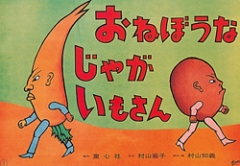
-
Sleepyhead Mr. Potato
Onebo na jagaimo-san
Kazuko Murayama, Tomoyoshi Murayama / 12 sheets
This 1937 work of children’s writer Kazuko Murayama was published as a kamishibai in 1971 by her husband, Tomoyoshi Murayama. Tomoyoshi Murayama was active in Japan’s modern theater movement and as a playwright, stage director, illustrator, and author. Here, the unique and enjoyable expressions of vegetables convey the importance of being an individual while also recognizing the different strengths of others and journeying with them?essential aspects of life.
- ISBN978-4-494-07598-0
- ¥1,760E
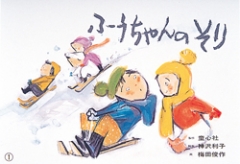
-
The Sleigh of Fu-chan
Fu-chan no sori
Toshiko Kanzaw, Shunsaku Umeda / 12 sheets
The fantasy world of well-known Japanese children’s author Toshiko Kanazawa meets the beautiful illustrations of Shunsaku Umeda in this charming capitalization on the kamishibai format. Fu-chan takes off on a sleighing adventure and is protected by a mother bear, emblematic of reverence toward nature. Fu-chan then returns home safely. A child’s will to action and eagerness for growth invite the sense of kyokan.
- ISBN978-4-494-07600-0
- ¥1,760E
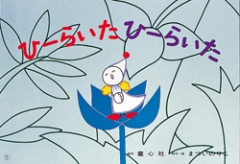
-
A Song for Pippo
Hi-raita, hi-raita
Noriko Matsui / 12 sheets
As audience members sing a phrase in nursery-rhyme style with the performer, a fairy’s wish to fly through the sky is granted little by little. Buoyed by the chanting of the audience, Pippo, the flower fairy, takes courage and holds fast to her dream; before she knows it, she flies, with a joy that spreads to the audience through kyokan. The experience resonates with each viewer thanks to the fresh approach of this audience-participation kamishibai.
- ISBN978-4-494-07615-4
- ¥1,760E
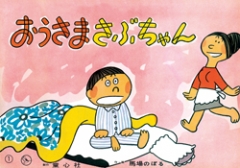
-
Sabu-chan the King
O-sama Sabu-chan
Noboru Baba / 12 sheets
Here Noboru Baba, creator of humorous works consistently based on a child’s perspective, takes up the subject of disciplining with love. Sabu-chan does not want to put on his clothes by himself, but is ever so tenderly portrayed . . . Through comical developments involving animals, a feeling of kyokan toward Sabu-chan naturally spreads to the children.
- ISBN978-4-494-07623-9
- ¥1,760E
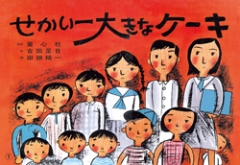
-
The Biggest Cake in the World
Sekai ichi oki na keki
Taruhi Furuta, Seiichi Tabata / 12 sheets
Writer Taruhi Furuta and artist Seiichi Tabata worked diligently to turn a portion of Robotto Kamii, a Japanese children’s book, into this kamishibai. It is the first in a series of four. The text addresses the audience from the first scene, extending the world of the story into the real world. Careful simplification of the overall structure also makes kyokan with Kamii easy to create.
- ISBN978-4-494-07624-6
- ¥1,760E
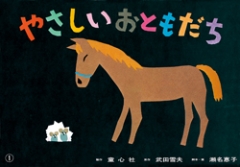
-
Kind Friends
Yasashii otomodachi
Yukio Takeda, Keiko Sena / 12 sheets
Keiko Sena has long explored the possibilities of harie (pasted paper) in her work as a picture book and kamishibai artist. The simplicity of her illustrations lends itself perfectly to this work. Thanks also to the vivid colors, both the friendship between a horse and some mice and the feeling of urgency when a fire breaks out spread quickly to audience members. The simple beauty of the kamishibai wraps children and adults alike in a feeling of warmth.
- ISBN978-4-494-07628-4
- ¥1,760E
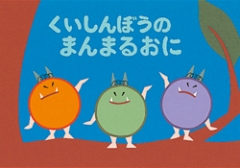
-
The Hungry Round Ogres
Kuishinbo no manmaru oni
Eiko Matsui / 12 sheets
This kamishibai teaches the mathematical concept of one-to-one correspondence while also teaching the “life” concept of each person being able to find happiness. The shape of the “hungry round ogres” attracts children, making these characters a hit. The joy of kyokan helps the world of numbers to capture children’s imaginations.
- ISBN978-4-494-07660-4
- ¥1,760E
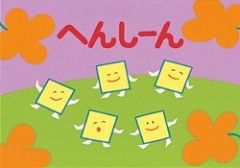
-
Transformation!
Henshi-i-n
Eiko Matsui / 8 sheets
As this kamishibai introduces the concept of doing arithmetic with units of five, it also shows children how amazing it is when individuals join forces to work for a better future. The unique use of color and simplification make wall artist Eiko Matsui’s illustrations very beautiful. At the end, when the audience calls out “transform,” five squares combine into a rectangle. The use of audience participation deepens everyone’s enjoyment of this story.
- ISBN978-4-494-07663-5
- ¥1,540E
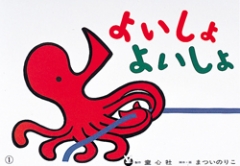
-
Heave-Ho, Heave-Ho
Yoisho yoisho
Noriko Matsui / 16 sheets
As the audience calls out, “Heave-ho, heave ho!” (yoisho, yoisho) items that an octopus and horse are pulling along with cords become visible. As everyone continues to “pull,” together with a dwarf and an elephant, look there! Something special appears. The final sheet has eight different text options on the back, so the ending can be tailored to introduce an activity or connect with a story. This is one of the few kamishibai destined to be performed without the stage.
- ISBN978-4-494-07713-7
- ¥2,090E
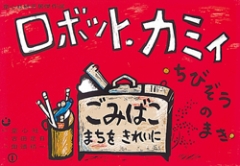
-
Kamii the Robot: Kamii and the Toy Elephant
Robotto Kamii: Chibizo no maki
Taruhi Furuta, Seiichi Tabata / 12 sheets
Children’s dreams of eating lots and lots of cake become connected with something much bigger in this kamishibai, which overflows with life. The children’s longing for cake becomes the wish to build a future in which everyone in town is happy; the development of this connection invites a rich sense of kyokan. The kamishibai makes the most of a fresh creativity and laudable perspective on children that could only have come from Taruhi Furuta and Seiichi Tabata.
- ISBN978-4-494-07848-6
- ¥1,760E
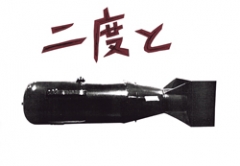
-
Never Again
Nido to
Eiko Matsui, Torahiko Ogawa et al. / 12 sheets
Wall artist Eiko Matsui created this kamishibai after holding discussions with the people of Nagasaki. The honorable memory of those killed by the atomic bomb, the atomic bomb survivors, the persons trying to forge peace?all have been carved into this remarkable 12-sheet narrative. As the illustrations in this uniquely effective kamishibai change from photographs to drawings, then from drawings to harie (pasted paper), viewers are moved one by one to deepen their commitment to “never again.”
- ISBN978-4-494-07863-9
- ¥1,760E
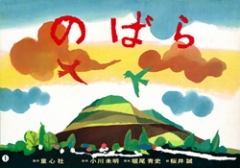
-
Wild Roses
Nobara
Mimei Ogawa, Seishi Horio, Makoto Sakurai / 12 sheets
The bloom of wild roses connects an aging soldier from a large country with a youthful soldier from a small country, but the two are soon parted as one of them becomes a casualty of war. The text by Seishi Horio makes the poignant story resonate even more powerfully with the audience. Makoto Sakurai’s illustrations emphasize the abrupt change from welcoming, beautiful surroundings to wartime conditions, and eloquently express the elderly soldier’s feelings in response. The importance of peace comes to reside deep in the heart.
- ISBN978-4-494-07864-6
- ¥1,760E
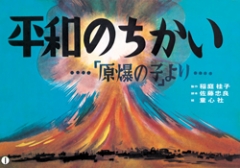
-
The Oath of Peace
Heiwa no chikai
Keiko Inaniwa, Churyo Sato / 16 sheets
This kamishibai first came out in 1952, the year after Genbaku no ko (Children of Hiroshima, published by Iwanami Shoten), and is based on that collection of testimonials by children who suffered due to the atomic bomb. Sculptor Churyo Sato’s illustrations convey the brutality of the A-bombs and the agony they caused, as well as a steadfast determination to uphold peace. This kamishibai was brought back into print in 2005, 60 years after World War II, as a kind of memorial.
- ISBN978-4-494-07865-3
- ¥2,090E
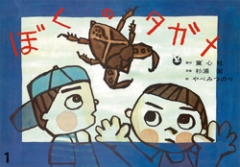
-
My Giant Water Bug
Boku no tagame
Hiroshi Sugiura, Mitsunori Yabe / 12 sheets
This was the first title published (in 1981) by an author who has worked on kamishibai for many years: Mitsunori Yabe. A giant water bug, one of the largest insects that lives in fresh water, opens a lively world to children. Originally conceived by Hiroshi Sugiura, this work steals audience members’ hearts thanks to Mitsunori Yabe’s passion for kamishibai and pursuit of different varieties of kamishibai expression.
- ISBN978-4-494-07906-3
- ¥1,760E
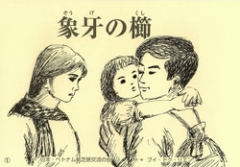
-
The Ivory Comb
Zoge no kushi
Bui Duc Lien / 12 sheets
The author of this work, who once fought for the liberation of Vietnam, worked to become a creator of kamishibai while also employed at a publishing company. The contents of the kamishibai overlap with the author’s own life, presenting a moving portrait of the Vietnam War and the proud people of Vietnam. Since 1991, kamishibai has been recognized in Vietnam as an important form of culture for children, and a number of kamishibai by Vietnamese authors have been published.
- ISBN978-4-494-07969-8
- ¥1,320E
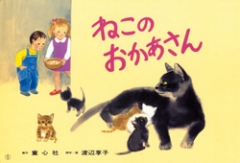
-
The Mother Cat
Neko no oka-san
Kyoko Watanabe / 12 sheets
Love and peace are the themes of many kamishibai by Kyoko Watanabe. This one, in which a mother cat rescues five kittens from a fire, is based on a true story. The amazing cat, in illustrations that capitalize on kamishibai’s simplicity, conveys the force of powerful love to the audience. The use of color is also excellent and effective.
- ISBN978-4-494-08751-8
- ¥1,760E
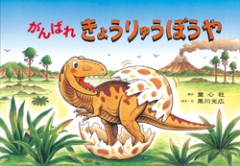
-
Go, Go, Little Dinosaur!
Ganbare kyoryu boya
Mitsuhiro Kurokawa / 16 sheets
This kamishibai exemplifies the work of Mitsuhiro Kurokawa, who has focused on extinct animals such as the dinosaurs. As a little boy dinosaur searching for his mother meets members of different dinosaur species, an entertaining, quintessentially kamishibai drama unfolds. At the same time, Mitsuhiro Kurokawa’s scientific perspective as a researcher of paleontology interests children in learning more.
- ISBN978-4-494-08831-7
- ¥2,420E
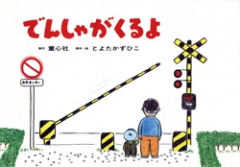
-
The Train is Coming!
Densha ga kuru yo
Kazuhiko Toyota / 8 sheets
The motion of removing pages in kamishibai is eminently suited to works about moving vehicles, but there are not yet many titles in the category. This kamishibai by Kazuhiko Toyota is sure to answer children’s expectations. It welcomes viewers to pass the time with a father and child as they wait for a train, wrapping them in a feeling of security and imparting a quiet joy.
- ISBN978-4-494-08840-9
- ¥1,540E
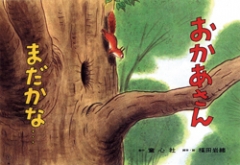
-
Is Mother Back Yet?
Oka-san mada kana
Iwao Fukuda / 12 sheets
This is a kamishibai by Iwao Fukuda, whose work regularly and carefully depicts the feelings of children as they go through everyday life. The progression of true-to-life illustrations, which uses the sliding in and out of sheets to advantage, helps the audience share a child’s feeling of unrest as he waits for his mother to come home. Kindly animals appear one after another; the final scene depicts the joy of having Mother return. This kamishibai imparts the secure feeling that, yes, things will turn out all right.
- ISBN978-4-494-08845-4
- ¥1,980E
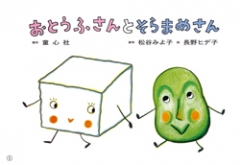
-
Tofu and Broad Bean
Otofu-san to soramame-san
Miyoko Matsutani, Hideko Nagano / 8 sheets
Why do broad beans have black lines in their skin? This folktale offers one explanation. The text by Miyoko Matsutani, who has produced a number of excellent kamishibai, tells the story in the sort of language that even young children can enjoy. Hideko Nagano’s warm and humorous illustrations showcase characters with a real sense of personality, evoking a world of spontaneity and fun.
- ISBN978-4-494-08970-3
- ¥1,540E
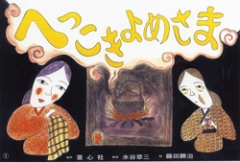
-
The Farting Young Wife
Hekkoki yome-sama
Shozo Mizutani, Katsuji Fujita / 12 sheets
This text by Shozo Mizutani, an author and longtime folktale researcher, warmly and affectionately tells the tale of Hekkoki yome, the farting bride. The kamishibai cheerfully and humorously conveys the strength to be found in everyday people. The energy that fuels the lives of ordinary Japanese is expressed with an original touch by Katsuji Fujita, effectively imparting courage to those who enjoy this kamishibai.
- ISBN978-4-494-08975-8
- ¥1,980E
